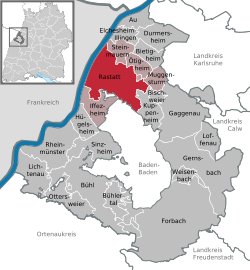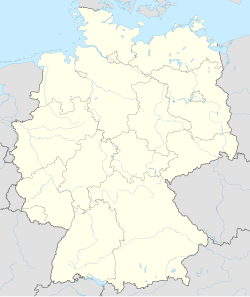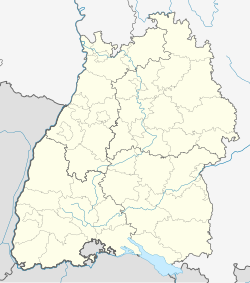Top Qs
Timeline
Chat
Perspective
Rastatt
Town in Baden-Württemberg, Germany From Wikipedia, the free encyclopedia
Remove ads
Rastatt (German pronunciation: [ˈʁaʃtat] ⓘ) is a town with a Baroque core, District of Rastatt, Baden-Württemberg, Germany. It is located in the Upper Rhine Plain on the Murg river, 6 km (3.7 mi) above its junction with the Rhine and has a population of around 51,000 (2022). Rastatt was an important place of the War of the Spanish Succession (Treaty of Rastatt) and the Revolutions of 1848 in the German states.
Remove ads
History
Summarize
Perspective



Until the end of the 17th century, Rastatt held little influence, but after its destruction by the French in 1689, it was rebuilt on a larger scale by Louis William, Margrave of Baden, the Imperial General in the Great Turkish War known popularly as Türkenlouis.
It then remained the residence of the Margraves of Baden-Baden until 1771. It was the location of the First and Second Congress of Rastatt, the former giving rise to the Treaty of Rastatt while the second ended in failure in 1799. In the 1840s, Rastatt was surrounded by fortifications to form the Fortress of Rastatt. For about 20 years previous to 1866, it was occupied by the troops of the German Confederation.[3]
The Baden revolution of 1849 began with a mutiny of soldiers at Rastatt in May 1849 under Ludwik Mieroslawski and Gustav Struve, and ended there a few weeks later with the capture of the town by the Prussians. (See The Revolutions of 1848 in the German states and History of Baden.) For some years, Rastatt was one of the strongest fortresses of the German empire, but its fortifications were dismantled in 1890.
In the same year, the town's railway station was relocated closer to the centre of Rastatt, from a location formerly outside the town walls, in what is now an industrial area.
Between 1946 and 1954, about twenty major criminal proceedings (known as the Rastatt Trials) for crimes against foreign workers and prisoners in smaller camps in the National Socialist camp system in south-west Germany took place in front of the French Military Administration's Tribunal Général on the basis of Control Council Law No. 10, along with more than 2000 defendants.
In 1992, a new Mercedes-Benz car factory started production in Rastatt.[4]
Remove ads
Local attractions
Rastatt and the surrounding area is home to a variety of historical buildings, includes palaces and castles such as Schloss Rastatt and Schloss Favorite. It lies in the vicinity of the Black Forest and the French border.
Twin towns – sister cities
 Fano, Italy
Fano, Italy Guarapuava, Brazil
Guarapuava, Brazil New Britain, Connecticut, United States
New Britain, Connecticut, United States Orange, France
Orange, France Vantaa, Finland
Vantaa, Finland Ostrov, Czech Republic
Ostrov, Czech Republic Woking, England, United Kingdom
Woking, England, United Kingdom
Transport
Air
Rastatt is served by Karlsruhe/Baden-Baden Airport, which is located 15 km (9.3 mi) to the south west of the town. Other nearby airports are Strasbourg Airport, located 81 km (50 mi) south west and Frankfurt Airport, located 151 km (94 mi) north of Rastatt.
Rail
Rastatt station provides train services to other parts of Baden-Württemberg. It is an important station for the Karlsruhe Stadtbahn, being served by four of its lines, which are operated by the Albtal-Verkehrs-Gesellschaft ("Alb Valley Transport Company", AVG). In addition, it is served by regional and long-distance trains operated by Deutsche Bahn. The station is located at chainage 96.5 km on the Rhine Valley Railway and at chainage 82.9 on the Rhine Railway (both chainages are based on the original distance from Mannheim). The station is also the beginning of the Murg Valley Railway.
Remove ads
Notable people

- Herman Fortunatus (1595–1665), Margrave of Baden-Rodemachern
- Charles William (1627–1666), Margrave of Baden-Rodemachern
- Augustus George (1706–1771), Margrave of Baden-Baden
- Joseph Frank (1771–1842), physician.[6]
- Wilhelm Stemmermann (1888–1944), general in the Wehrmacht
- Luise Adolpha Le Beau (1850–1927), pianist and composer of classical music
- Bodo Uhse (1904–1963), writer
- Oliver Hassencamp (1921–1988), cabaret artist, actor and author
- Ricky King (born 1946), guitarist and musician
- Joachim Schuster (born 1962), politician (SDP)
Sport
- Christian Seifert (born 1969), football functionary
- Andria Lloyd (born 1971), Jamaican sprinter, studied locally, team bronze medalist at the 1996 Summer Olympics
- Philipp Laux (born 1973), footballer, played 230 games
- Christian Essig (born 1986), retired footballer, played 295 games
Remove ads
In literature
The plot of the historical novel The Lenz Papers by Stefan Heym (published London 1964) is set in 1849 Rastatt, during the failed revolutions in Germany in 1848.
Gallery
- Town hall
- Murg river
- Pagodenburg and water tower
- Former Franciscan monastery
- Ludwig-Wilhelm school
- Street theatre festival
- Hopfenschlingel beer garden
- Schloss Favorite
References
Further reading
External links
Wikiwand - on
Seamless Wikipedia browsing. On steroids.
Remove ads














